语用学讲义2:预设
- 格式:ppt
- 大小:209.00 KB
- 文档页数:11
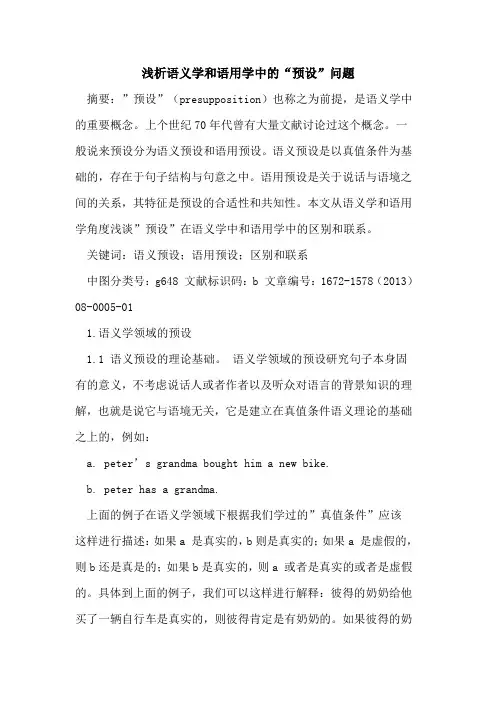
浅析语义学和语用学中的“预设”问题摘要:”预设”(presupposition)也称之为前提,是语义学中的重要概念。
上个世纪70年代曾有大量文献讨论过这个概念。
一般说来预设分为语义预设和语用预设。
语义预设是以真值条件为基础的,存在于句子结构与句意之中。
语用预设是关于说话与语境之间的关系,其特征是预设的合适性和共知性。
本文从语义学和语用学角度浅谈”预设”在语义学中和语用学中的区别和联系。
关键词:语义预设;语用预设;区别和联系中图分类号:g648 文献标识码:b 文章编号:1672-1578(2013)08-0005-011.语义学领域的预设1.1 语义预设的理论基础。
语义学领域的预设研究句子本身固有的意义,不考虑说话人或者作者以及听众对语言的背景知识的理解,也就是说它与语境无关,它是建立在真值条件语义理论的基础之上的,例如:a. peter’s grandma bought him a new bike.b. peter has a grandma.上面的例子在语义学领域下根据我们学过的”真值条件”应该这样进行描述:如果a 是真实的,b则是真实的;如果a 是虚假的,则b还是真是的;如果b是真实的,则a 或者是真实的或者是虚假的。
具体到上面的例子,我们可以这样进行解释:彼得的奶奶给他买了一辆自行车是真实的,则彼得肯定是有奶奶的。
如果彼得的奶奶给他买了辆自行车是假的,那么彼得还是有个奶奶的。
而彼得有个奶奶,那他奶奶给他买自行车这件事是可真的也可是假的。
也就是说彼得的奶奶给他买不买自行车都是可以的。
1.2 语义预设的特点。
一般说来,语义预设有稳定性(stability)、可变性(changeability)这两个基本特点。
(俞如珍,1996,25)①稳定性(stability)。
语义预设依赖于语言内部词语的词汇意义和句子结构,不受外部语境的影响,因此是稳定的。
对语句进行否定或者加以疑问都不会影响句意和句子预设。
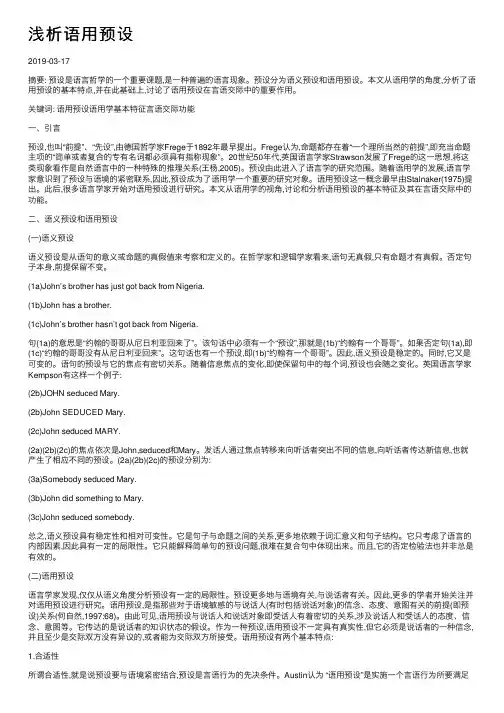
浅析语⽤预设2019-03-17摘要: 预设是语⾔哲学的⼀个重要课题,是⼀种普遍的语⾔现象。
预设分为语义预设和语⽤预设。
本⽂从语⽤学的⾓度,分析了语⽤预设的基本特点,并在此基础上,讨论了语⽤预设在⾔语交际中的重要作⽤。
关键词: 语⽤预设语⽤学基本特征⾔语交际功能⼀、引⾔预设,也叫“前提”、“先设”,由德国哲学家Frege于1892年最早提出。
Frege认为,命题都存在着“⼀个理所当然的前提”,即充当命题主项的“简单或者复合的专有名词都必须具有指称现象”。
20世纪50年代,英国语⾔学家Strawson发展了Frege的这⼀思想,将这类现象看作是⾃然语⾔中的⼀种特殊的推理关系(王杨,2005)。
预设由此进⼊了语⾔学的研究范围。
随着语⽤学的发展,语⾔学家意识到了预设与语境的紧密联系,因此,预设成为了语⽤学⼀个重要的研究对象。
语⽤预设这⼀概念最早由Stalnaker(1975)提出。
此后,很多语⾔学家开始对语⽤预设进⾏研究。
本⽂从语⽤学的视⾓,讨论和分析语⽤预设的基本特征及其在⾔语交际中的功能。
⼆、语义预设和语⽤预设(⼀)语义预设语义预设是从语句的意义或命题的真假值来考察和定义的。
在哲学家和逻辑学家看来,语句⽆真假,只有命题才有真假。
否定句⼦本⾝,前提保留不变。
(1a)John’s brother has just got back from Nigeria.(1b)John has a brother.(1c)John’s brother hasn’t got back from Nigeria.句(1a)的意思是“约翰的哥哥从尼⽇利亚回来了”。
该句话中必须有⼀个“预设”,那就是(1b)“约翰有⼀个哥哥”。
如果否定句(1a),即(1c)“约翰的哥哥没有从尼⽇利亚回来”。
这句话也有⼀个预设,即(1b)“约翰有⼀个哥哥”。
因此,语义预设是稳定的。
同时,它⼜是可变的。
语句的预设与它的焦点有密切关系。
随着信息焦点的变化,即使保留句中的每个词,预设也会随之变化。


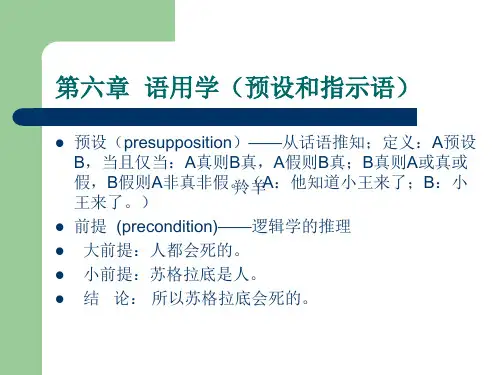

![[整理]论“预设”的概念及其分类](https://uimg.taocdn.com/3f5ca6fe6394dd88d0d233d4b14e852458fb39f5.webp)
论“预设”的概念及其分类摘要:预设的概念已产生一百多年,通常又被称为前提。
预设是指暗指在语句中的一种预先设定的信息,在交际中通常表现为双方都可理解、都可接受的那种背景知识。
具体主要体现在四个方面:在话语中的表现、就成功的交际而言、真值判断情况、预设与它所依附的语句之间的关系。
其分类主要有两种方式。
关键词:预设的概念预设的含义预设的分类一、“预设”概念的提出“预设”这一概念是由德国哲学家、逻辑学家弗雷格(G.Frege)于1892年首次提出来的。
在语言学界,预设通常又称为“前提”,而在逻辑学界,为了与推理中的前提(premise)相区别,人们一般都把它叫做预设(presupposition)。
二、“预设”的含义预设是指暗指在语句中的一种预先设定的信息,在交际中通常表现为双方都可理解、都可接受的那种背景知识。
这只是对预设内涵的一般概括,具体包括:第一、就其在语言中的表现来说,预设是没有明确地、直接地表达出来的信息,它通常蕴藏在现存的话语断言之中。
请看下面的几个例句:(1,a)请帮我把门打开。
(1,b)小王把那些衣服洗了。
(1,c)您喜欢红色的那件衣服,还是蓝色的那件?通过分析,我们知道,上面三个句子至少包含了如下的预设,(2,a)门是关着的。
(2,b)那些衣服是脏的。
(2,c)顾客已有意向购买衣服。
很显然,从听话人的角度看,预设并不是话语(1,a)、(1,b)、(1,c)表达的意思,而是人们透过这些话语的表层并根据逻辑语义分析的意思。
第二、就成功的交际来说,预设总是表现为一种“无争议信息”。
这种“无争议信息”也就是交际双方都可理解、都可接受的背景知识。
这一点正是预设最本质的特征。
第三、如果把句子直接表达于外的命题称为“显前提”的话,预设就是蕴藏于内的“隐前提”。
从逻辑命题的真假方面考虑,预设为真是确保“显前提”具有逻辑真值的必要条件,也是保证语句获得真结论的必要条件。
具体来说,如果预设为假,则“显前提”没有逻辑真值,即这个“显前提”既不能取真值,也不能取假值,而只能取“无意义”的值。
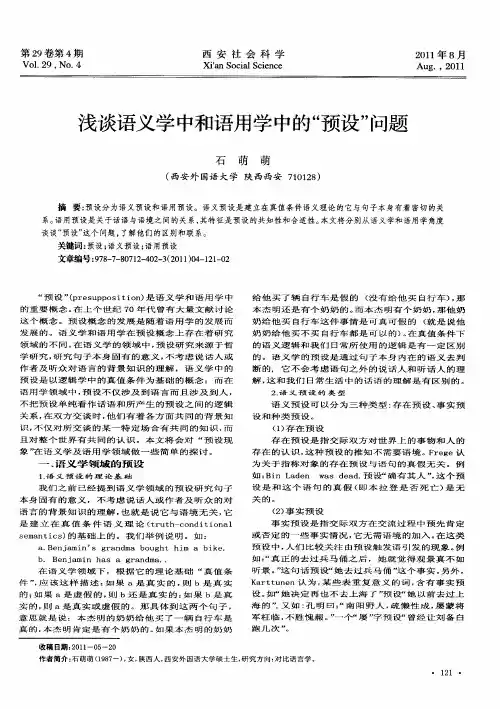

2021语义预设和语用预设范文 预设是说话者在说出一个句子时所包含的假设,也就是说话者为保证话语的合适性而必须满足的前提。
预设这一概念最早是德国著名逻辑学和数学家Frege 于 1892 年提出的,它是当代语言学家和哲学家共同研究和关注的焦点之一。
预设是理解和使用语言的重要基础,是依靠逻辑、语义、语境等推断出来的话语先决条件,反映了说话者与话语之间的关系。
逻辑学上对预设的研究是在命题层面展开的,认为预设与语句的真假无关;语义学对预设的研究是在句子层面展开的,认为预设是静态的语言现象;而语用学对预设的研究是结合语境、句子、意义,以及说话者和听话者信息等研究的,语用学认为预设是语境的、动态的,是从不同语境的角度来研究的。
一、语义预设和语用预设 预设在语义和语用这两个不同范围内有不同的意义。
当然,这并不是说语义预设和语用预设是两个对立体,而是语言学家们对同一预设的两种不同角度的解释。
语义预设是逻辑语义学视角下的预设,而语用预设是语用学视角下的预设。
两者可能重合也可能不重合。
(一)语义预设观 在逻辑语义学中,语言学家将预设看作是句子及命题之间的关系,他们从值条件的角度分析预设,将预设看作是一个命题是否成立的必要条件,目的是为了展示句子之间的逻辑关系来判断命题真假。
语义预设是狭义的预设,是仅存在于句子层面的预设,因而是客观的、非语境的、静态的。
预设在语义方面的研究是始于英国著名哲学家Strawson,他在《逻辑理论导论》一书中对预设进行了定义。
“一个命题S 预设 P,而且仅当 P 是 S 有真值或价值的必要条件。
”逻辑学区分了语句和命题,满足预设是一个句子成为命题的必要条件。
一般情况下,一个句子有三种意义:断言意义、蕴含意义和预设意义,这三类意义的区别在于,它们要求不同的真值条件。
人们常用否定语句来检验判断语句的断言是否有内涵和预设。
语义预设观是从两个命题的关系以及三值逻辑观即真、假、非真非假的角度来研究预设的,并把预设看作是其真值为一个预设性命题为真的前提的命题,因此语义预设是只发生在词汇层面上的而不超过句子层面的,语义预设是纯粹的语义关系,和语境的变化没有关系。
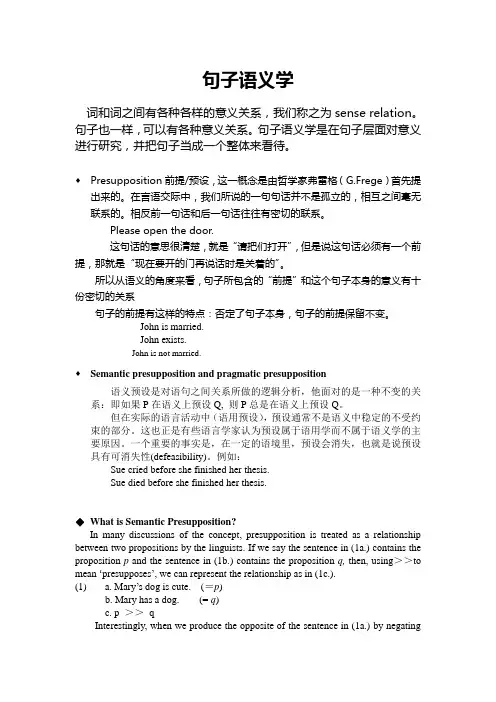
句子语义学词和词之间有各种各样的意义关系,我们称之为sense relation。
句子也一样,可以有各种意义关系。
句子语义学是在句子层面对意义进行研究,并把句子当成一个整体来看待。
◆Presupposition前提/预设,这一概念是由哲学家弗雷格(G.Frege)首先提出来的。
在言语交际中,我们所说的一句句话并不是孤立的,相互之间毫无联系的。
相反前一句话和后一句话往往有密切的联系。
Please open the door.这句话的意思很清楚,就是“请把们打开”,但是说这句话必须有一个前提,那就是“现在要开的门再说话时是关着的”。
所以从语义的角度来看,句子所包含的“前提”和这个句子本身的意义有十份密切的关系句子的前提有这样的特点:否定了句子本身,句子的前提保留不变。
John is married.John exists.John is not married.◆Semantic presupposition and pragmatic presupposition语义预设是对语句之间关系所做的逻辑分析,他面对的是一种不变的关系:即如果P在语义上预设Q, 则P总是在语义上预设Q。
但在实际的语言活动中(语用预设),预设通常不是语义中稳定的不受约束的部分。
这也正是有些语言学家认为预设属于语用学而不属于语义学的主要原因。
一个重要的事实是,在一定的语境里,预设会消失,也就是说预设具有可消失性(defeasibility)。
例如:Sue cried before she finished her thesis.Sue died before she finished her thesis.◆What is Semantic Presupposition?In many discussions of the concept, presupposition is treated as a relationship between two propositions by the linguists. If we say the sentence in (1a.) contains the proposition p and the sentence in (1b.) contains the proposition q, then, using>>to mean …presupposes‟, we can represent the relationship as in (1c.).(1) a. Mary‟s dog is cute. (=p)b. Mary has a dog. (= q)c. p >>qInterestingly, when we produce the opposite of the sentence in (1a.) by negating it (= NOT p), as in (2a.), we find that the relationship of presupposition does not change. That is, the same proposition q, repeated as (2b.), continues to be presupposedby NOT p, as shown in (2c.).(2) a. Mary‟s dog isn‟t cute. (=NOT p)b. Mary has a dog. (= q)c. NOT p >>qPresupposition is an inference(推论)to the proposition of the sentence. Take the following sentences for example again:e.g. (3) John is married.(4) John exists.(5) John is not married.Comment: if (3) is true, (4) is true; if (3) is not true, (4) is still true. In this case, we can say both (3) and (5) presuppose (4). A presupposition is something the speaker assumes to be the case prior to making an utterance. Speakers, not sentences, have presuppositions. An entailment is something that logically follows from what is asserted in the utterance. Sentences, not speakers, have entailments.◆Semantic presupposition would be based on the following definition:Sentence A semantically presupposes another sentence B iff:if and only if, iff是充分必要条件(a) in all situations where A is true, B is true(b) in all situations where A is false, B is true◆Types of presuppositionPotential presupposition: in the analysis of how speakers‟ assumptions are typically expressed, presupposition has been associated with the use of a large number of words, phrases, and structures. These linguistic forms shall be considered as indicators of potential presuppositions, which can only become actual presuppositions in contexts with speakers. The following kinds of presuppositions are all potential presuppositions. Now we‟ll look at the major presupposition types marked by different linguistic features.◆Existential presupposition: presuppose the existence of something.(my). It is not only assumed to be present in possessive constructions, but more generally in any definite descriptions such as definite noun phrase with determines …the‟, …this‟, …that‟, …these‟, …those‟, etc. By using any of the expressions in (16), the speaker is assumed to be committed to the existence of the entities named.(16) e.g. The king of Sweden, the cat, the girl next door (Yule, 2004: 27)◆Factive presupposition: presuppose something as a fact.(know). A number of factive verbs, such as …realize‟in (17a) and …regret‟in (17b), as well as phrases involving …be‟ with …aware‟ in (17c), …odd‟ in (17d), and …glad‟ in (17e) have factive presuppositions.(17) a. She didn‟t realize he was ill.(>>He was ill)b. We regret telling him.(>>We told him)c. I wasn‟t aware that she was married.(>>She was married)d. It isn‟t odd that he left early.(>>He left early)e. I‟m glad that it‟s over.(>>It‟s over)The presupposed information following the verb …know‟ can be treated as a fac t, and is described as a factive presupposition. Words like know, realize, regret as well as phrases involving …be‟ with …aware‟, …odd‟, and …glad‟ have factive presuppositions. (Yule, 2004: 27-28)◆Lexical presupposition: when a specific word triggers a presupposition. It is featured by implicative verbs like …manage‟, …start‟, …stop‟, …forget‟, etc. Generally speaking, in lexical presupposition, the use of one form with its asserted meaning is conventionally interpreted with the presupposition that another (non-asserted) meaning is understood.Each time you say that someone …managed‟to do something, the asserted meaning is that the person succeeded in some way. When you say that someone …didn‟t manage‟, the asserted meaning is that the person did not succeed. In both cases, however, there is a presupposition (non-asserted) that the person …tried‟to do that something. So, …managed‟ is conventionally interpreted as asserting …succeeded‟ and presupposing …tried‟.(18) a. He stopped smoking.(>>He used to smoke)b. They started complaining.(>>They weren‟t complaining before)c. You‟re late again.(>>You were late before)Lexical presupposition: in lexical presupposition, the use of one form with its asserted meaning is conventionally interpreted with the presupposition that another(non-asserted) meaning is understood. For example, someone …managed‟ to do something, the asserted meaning is that the person succeeded in some way. Someone …didn‟t manage‟; the asserted meaning is that the person did not succeed. In both cases, there is a presupposition (non-asserted) that the person …tried‟ to do that something. So …managed‟is conventionally interpreted as asserting …succeeded‟ and presupposing …tried‟. Other examples, involving the lexical items, are …stop‟, …start‟, and …again‟. (Yule, 2004: 28)◆Structural presupposition: certain sentence structures presuppose something to be true.(wh-questions). We might say that speakers can use such structures to treat information as presupposed (i.e. assumed to be true) and hence to be accepted as true by the listener.For example, the wh-question construction in English, as shown in (19a) and (19b), is conventionally interpreted with the presupposition that the information after the wh-form is already known to be the case.a. When did he leave?(>>He left)b. Where did you buy the bike?(>>You bought the bike)Certain sentence structures have been analyzed as conventionally and regularly presupposing that part of the structure is already assumed to be true. We might say that speakers can use such structures to treat information as presupposed (i.e. assumed to be true) and hence to be accepted as true by listener. For example, the wh-question construction in English is conventionally interpreted as that the information after the wh-form is already known to be the case. Such structurally-based presuppositions may represent subtle ways of making information that the speaker believes appear to be what the listener should believe.(wh-questions)◆Non-factive presupposition: It is one that is assumed not to be true. Verbs like …dream‟, …imagine‟, and …pretend‟, as shown in (20), are used with the presupposition that what follows is not true.(20). a. I dreamed that I was rich.(>>I was not rich)b. We imagined we were in New York.(>>we were not in New York)He pretends to be ill.(>>He is not ill)◆Counter-factural presupposition: What is presupposed is not only not true, but is the opposite of what is true, or …contrary to facts‟. (Conditional structure)A conditional structure of the type shown in (21), generally called a counterfactual conditional, presupposes that the information in the if-clause is not true at the time of utterance.(21). If you were my friend, you would have helped me.(>>you are not my friend)Summary:◆The properties of presuppositions★Cancel ability / Defeasibility:Levinson(1983:186) states that they can be cancelled out by either the immediate linguistic context or by some wider context or mode of discourse. If we say …The committee failed to reach a decision‟, it presupposes that they tried, but we can cancel out that presupposition if we add …because they didn‟t even get round to discussing it‟. Similarly, we can argue presupposition out of the way by a variant on the reductio ad absurdum (the disproof of a proposition by showing that its conclusion can only be absurd) mode of discourse: …He didn‟t do it, and she didn‟t do it…In fact, nobody did it ‟. They are defensible in (a) certain discourse contexts, (b) certain intra-sentential context. This property will prove to be the undoing(doing away with) of any possible semantic theory of presupposition. They are defeasible in certain intra-sentential contexts and certain discourse context, for example,(1) Sue cried before she finished her thesis.(2) Sue finished her thesis.(3)Sue died before she finished her thesis.In Sentence(3) the presupposition seems to drop out, since we generally hold that people do not do things after they die, it follows that she could not have finished her thesis. They are liable to evaporate in certain contexts, either immediate linguistic context or the less immediate discourse context, or on circumstances where contrary assumptions are made.(Levinson,2001, p187)Another kind of contextual defeasibility arises in certain kinds of discourse contexts. For example, the cleft sentence 1 is supposed to presuppose 2:1. It isn‟t Luke who will betray you.2. Someone will betray you.You say that someon e in this room will betray you. Well maybe so. But it won‟t be Luke who will betray you, it won‟t be Paul, it won‟t be Matthew, and it certainly won‟t be John. Therefore no one in this room is actually going to betray youHere each of the cleft sentence(It won‟t be Luke, etc.)should presuppose that there will be someone who will betray the addressee. But the whole purpose of the utterance 1 is, of course, to persuade the addressee that no one will betray him, as stated in the conclusion. So the presupposition is again defeated; it was adopted as a counterfactual assumption to argue to the untenability (站不住脚) of such an assumption.So far we have shown that some of the core examples of presuppositional phenomena are subject to presupposition cancellation in certain kinds of context, namely:(i)Where it is common knowledge that the presupposition is false, the speaker is not assumed to be committedto the truth of the presupposition(ii) Where what is said, taken together with background assumptions, is inconsistent with what is presupposed, the presuppositions are cancelled, and are not assumed to be held by the speaker(iii) In certain kinds of discourse contexts, presuppositions can systematically fail to survive.3.4.2 Presuppositions are apparently tied to particular aspects of surface structure. This property may serve to distinguish presupposition from conversational implicatures (which are tied to the context rather than the surface structure.), the other major form of pragmatic inference.( Levinson, S. C. 2001)There are no doubt many other kinds of contextual defeasibility as well, but these examples are sufficient to establish that presuppositions are defeasible by virtue of contrary beliefs held in a context. There are also many kinds of intra-sentential cancellation of suspension of presuppositions.(Levinson, 190)3.4.3 Projection in presupposition There is a basic expectation that the presupposition of a simple sentence will continue to be true when that simple sentence becomes part of a more complex sentence. This is one version of the general idea that the meaning of the whole sentence is a combination of the meaning of its parts. However, the meaning of some presuppositions (as …parts‟) does not survive to become the meaning of some complex sentences (as …wholes‟). This is known as the projection problem. (Yule, 2004: P30-33) Another explanation given by Levinson (Levinson, 1983: 191) is that Frege held that meanings of sentences are compositional, i.e. that the meaning of the whole expression is a function of the meaning of the parts. It was originally suggested by Langendoen & Savin (1971) that this was true of presuppositions too, and moreover that the set of presupposition of the complex whole is the simple sum of the presuppositions of the parts, i.e. if S0 is a complex sentence containing sentences S1, S2…S n as constituents, then the presuppositions of S0 = the presuppositions of S1 + the presuppositions of S2 …+ the presuppositions of S n .But such a simple solution to the presuppositions of complex sentences is far from correct, and it has proved in fact extremely difficult to formulate a theory that will predict correctly which presuppositions of component clauses will in fact be inherited/maintained by the complex whole. This compositional problem is known as the projection problem for presuppositions, and the particular behaviour of presuppositions in complex sentences turns out to be the really distinctive characteristic of presuppositions. (The Chinese version may be a little easier to understand:详见索振羽,《语用学教程》2000.北京大学出版社P136-140)◆Presupposition triggers: Some of the kinds of words and structures that seem to trigger presuppositions. Definite noun phrase/definite descriptions: words like the, this, that, these, those and possessives like my, Mary’s, your, prepositional phrase like with(two heads), in, etc. trigger the basic kind of presupposition. The possessives lead to a particularly strong presupposition about the existence of something; this is sometimes called existential presupposition. (Peccei, p20)John saw/didn‟t see the man with two heads.》there exists a man with two headsWH-words like when, why, how, etc. used either to ask questions or to introduce a subordinate clause to trigger the presupposition that the speaker has assumed “the person in question did something” is true. (Peccei, p 21)Mr. Givens, why is it important for people to understand body language---that is, communication by means of movements and gestures?Where do we get mannerisms such as these?Verbs that can trigger presuppositions: implicative verbs, factive verbs, change of state verbs and verbs of judging.1) Implicative verbs(含蓄动词): manage, forget, happen, avoid etc. triggers the presupposition that some actions were conducted(manage), not expected(happen), or should have been conducted(forget).John managed/didn‟t manage to open the door》John tried to open the doorJohn forg ot /didn‟t forget to lock the door》John ought to have locked, or intended to lock, the doorsome further implicative predicates: X happened to V 》X didn‟t plan or intend to V; X avoid Ving 》X was expected to, or usually did, or ought to V2) factive verbs(述实动词/事实动词a verb followed by a clause which the speaker or writer considers to expressa fact:know, realize, regret, deplore(谴责), I am aware, it is strange, it is odd that, be sorry that, be proud that, be indifferent that, be glad that, be sad that, etc. triggers the presupposition that what follows is a fact。
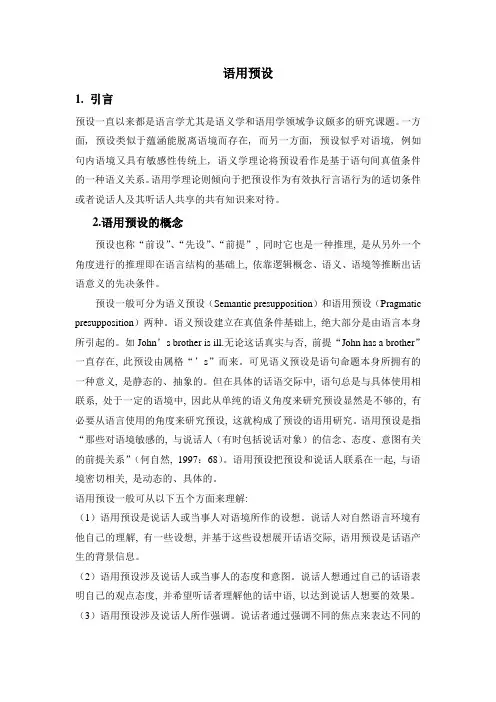
语用预设1.引言预设一直以来都是语言学尤其是语义学和语用学领域争议颇多的研究课题。
一方面, 预设类似于蕴涵能脱离语境而存在, 而另一方面, 预设似乎对语境, 例如句内语境又具有敏感性传统上, 语义学理论将预设看作是基于语句间真值条件的一种语义关系。
语用学理论则倾向于把预设作为有效执行言语行为的适切条件或者说话人及其听话人共享的共有知识来对待。
2.语用预设的概念预设也称“前设”、“先设”、“前提”, 同时它也是一种推理, 是从另外一个角度进行的推理即在语言结构的基础上, 依靠逻辑概念、语义、语境等推断出话语意义的先决条件。
预设一般可分为语义预设(Semantic presupposition)和语用预设(Pragmatic presupposition)两种。
语义预设建立在真值条件基础上, 绝大部分是由语言本身所引起的。
如John’s brother is ill.无论这话真实与否, 前提“John has a brother”一直存在, 此预设由属格“’s”而来。
可见语义预设是语句命题本身所拥有的一种意义, 是静态的、抽象的。
但在具体的话语交际中, 语句总是与具体使用相联系, 处于一定的语境中, 因此从单纯的语义角度来研究预设显然是不够的, 有必要从语言使用的角度来研究预设, 这就构成了预设的语用研究。
语用预设是指“那些对语境敏感的, 与说话人(有时包括说话对象)的信念、态度、意图有关的前提关系”(何自然, 1997:68)。
语用预设把预设和说话人联系在一起, 与语境密切相关, 是动态的、具体的。
语用预设一般可从以下五个方面来理解:(1)语用预设是说话人或当事人对语境所作的设想。
说话人对自然语言环境有他自己的理解, 有一些设想, 并基于这些设想展开话语交际, 语用预设是话语产生的背景信息。
(2)语用预设涉及说话人或当事人的态度和意图。
说话人想通过自己的话语表明自己的观点态度, 并希望听话者理解他的话中语, 以达到说话人想要的效果。
三、语用预设(一)关于语用预设1.语用预设的概念上个世纪七十年代初,“语言学家斯塔尔内克尔和凯南等人便提出了与语言运用现实语境密切相关联的‘语用预设’,以代替语义预设,目的是避免其封闭的句义限制、非语境性、静态性等弱点,实现预设的语境性、开放性、动态性,尤其是预设的合适性和共知性。
”①斯塔尔内克尔认为:“关于预设的一个粗略的定义可以是:一个谈话者在谈话中的一个给定的时间里设置P,仅当在他的语言行为中,他倾向于这样行动:好像他认为P当然真,也好像他假定了他和他的听众一样地认为P当然真。
”②后来又修正为“一个命题B在已给定的语境里是一个说话人的语用预设,如果说话人假定或者相信B,并且假定或者相信他的听众认为他正在做出这些假定或具有这些信仰。
”③预设不但与语境有关,而且与说话人有关,即预设不仅是句子和命题之间的关系,还包括说话人与语段之间的关系:如果一个命题是说话人在特定语境中的语用预设,这个命题不仅是说话人本身相信的,而且是说话人相信这一命题能够被听话人接受和认同。
王娟(2006)“对于语用预设,目前还没有一个普遍接受的定义,不同的语言逻辑学家有诸如不同的理解和阐释,有的理解较概括,有的理①杨翠(2006)《语言学中的预设分析》。
②[美]R.斯涛纳克尔(1972),《论预设》,胡泽洪译。
另:斯涛纳克尔即斯塔尔内克尔,不同学者的译法不同。
③斯涛纳克尔(1974),转引自杨翠(2006)《语言学中的预设分析》。
12 解较狭窄,归结起来主要有以下三种说法:“第一种从言语行为角度出发,把预设定义为:有效言语行为的条件,即实施某一言语行为所需要满足的恰当条件,或是使一句话语具有必要的社会实效性所必须满足的条件。
预设不构成话语的语句意义,只是为运用话语创造基础,使言语活动能达到交际的目的。
例如:‘请开门! 这个祈使句可用来实施一项表示‘请求’的言语行为,而这项言语行为必须具备下述条件时才是有效的,即交谈者之间的关系允许其中一个人去麻烦另一个人,受话者有能力完成‘开门’这个动作,并知道发话者指哪一扇门,而且门是关着的,等等。
080214218 潘丽语用预设及其应用1.语用预设的含义及主要特征预设(presupposition),又译为“前提”,“前设”,“先设”,它是一种推理,是从另外一个角度进行的推理:在语言结构的基础上,依据逻辑概念、语义、语境等推断出话语意义的先决条件。
预设一般分为语义预设(Semantic presupposition)和语用预设(Pragmatic presupposition)两种。
语用预设是指“那些对语境敏感的,与说话人(有时包括说话对象)的信念、态度、意图有关的前提”(何自然,1997:68)。
语用预设把预设和说话人联系在一起,与语境密切相关,是动态的、具体的。
语用预设就其本身而言,具有主观性和隐蔽性的特点,而就交际过程而言,具有合适性和共知性的特点。
主观性是指预设总是倾向于发话者的经验和知识背景。
隐蔽性由于预设是话语之外隐含的某种信息,它不属于话语的基本信息,而是附加的信息,即言外之义。
而共知性是指谈话双方所共同知道的语用信息。
语用预设的合适性即指预设要与语境紧密结合。
另外,语用预设还具有单向性。
所谓单向性是指语用预设是发话人在谈话中自己单方面做出的,并没有与受话人进行协商,这是相对于语用预设本身而言的。
语用预设的这些特点决定了其在话语交际中具有举足轻重的作用。
2.语用预设的分类根据不同的标准可对语用预设作出不同的分类。
根据其是否与实际相符,可分为真实语用预设与虚假语用预设;根据其在认知过程中的地位不同,可分为典型语用预设和非典型语用预设;根据发话人对所构预设的确定情况不同,可分为确定性语用预设和不确定性语用预设;根据来源不同,可分为句子语用预设和语篇语用预设;根据交际角色不同,可分为发话人语用预设和受话人语用预设。
对语用预设的分类,是预设理论自身建设的需要。
对语用预设作出多视角的分类,不仅有助于明确这一概念的外延,而且有助于明确其内涵,有助于深化对预设本质特征的认识。
3.语用预设的应用价值释例3.1语用预设与幽默交际双方共有的背景知识是预设的前提,只有在了解前提的基础上,交际才能够顺利进行。
浅谈语义预设及语用预设/h11、预设理论简介Frege最早讨论预设问题,他说:当我们说到“月亮”时,我们预设了该指称的存在。
当今当今西方语言学界对预设有一种常见定义,是通过与“蕴涵”相区别而给出的。
所谓蕴是一个语句的逻辑后果,而预设则是一个话语的前提条件。
Kempson总结过蕴涵与预设的别: A蕴涵B,则当且仅当:A真B必真,A假B可真可假,B假A必假;A预设B,则当且仅当:A真B必真,A假B亦真,B假A可真可假。
例如:“张三不再爱李四”蕴涵“张三现在不爱李四”并且预设“张三曾经爱李四”。
Levinson则直接利用“蕴涵”概念给出了这样一个定义: A预设了B,则当且仅当:A蕴涵了B,并且非A也蕴涵了B。
试以Russell给出的一个着名例子为例: “The King of France is wise.”(A)蕴涵了“There is a present king of France.”(B),前者矛盾命题“The King of France is not wise.”(非A)同样蕴含了“There is a pre sent king of France.” (B)。
从以上的论述可以看出,预设具有这样一个根本特征:即使在否定命题下,预设仍保持为一个常值。
2、语义预设2.1 语义预设的基础理论预设的语义研究始于英国着名哲学家斯特劳逊,他在《逻辑理论导论》(1952)一书中对预设进行了如下定义:“一个命题S预设S’,而且仅当S’是S有真值或假值的必要条件。
”语义学领域的预设是建立在真值条件语义理论(truth -conditional semantics)的基础上的。
如:(1a) Mark’s father bought him a book.(1b) Mark has a father.在真值条件语义逻辑下,这两句话的真实性关系可以描述为:如果(1a)是真实(true)的,则(1b)是真实(true)的;如果(1a)是虚假(false)的,则(1b)还是真实(true)的;如果(1b)是真实(true)的, 则(1a)是真实(true)或虚假(false)的。
㈡预设 1)定义:就话语本⾝表达的意义⽽⾔,通过背景知识断⾔有句义甲就必然有句义⼄就是说甲以⼄为预设。
2)预设和蕴含区别: ①蕴含在句⼦的断⾔范围之内,是句⼦的基本信息; ②预设不在句⼦的断⾔范围之内,是句⼦的背景信息。
3)预设对⾔语表达和理解的影响:避免重复罗嗦。
6.歧义 1)定义:指同⼀形式的语⾔符号序列可能表达不同意义的现象。
2)歧义以语⾔符号序列的同形为前提条件。
3)歧义与模糊的区别: ①模糊指语⾔形式所反映的对象只有⼀个⼤致的范围,⽽没有明确的界限,意义之间难以绝对划分清楚。
歧义指同形的语⾔符号中具有两个或两个以上不同的意义。
②在⾔语交际中,歧义可以通过上下⽂语境和情景语境来消除。
⽽模糊始终是模糊的。
4)歧义与笼统性区别: ①统来源于语义的概括性特点是指对同类对象的不同成员进⾏抽象概括⽽产⽣的。
②歧义来源于语义和表达形式之间的⽭盾。
5)影响歧义难度的因素: ①与各种解释的相对频率有关系 ②与歧义形式本⾝的特点有关系。
6)歧义的类型:①词汇歧义②组合歧义 备注:㈠词汇歧义:指由词汇上的原因造成的歧义。
词语的同⾳异义可能造成⼝头歧义。
词语的同形异义也可能造成歧义。
词语的⼀词多义也可能造成歧义。
㈡组合歧义: 1)定义:指由词语组合关系上的原因造成的歧义。
2)分类:①语法结构歧义②语义结构歧义 (三)如果相同的词语之间可以有不同的句法结构关系,就有可能造成歧义。
如果相同的词语之间可以有不同的层次构造,也有可能造成歧义。
如果相同的词语之间可以有不同的语义结构关系,就有可能造成歧义。